A guide to mid-range guidance systems
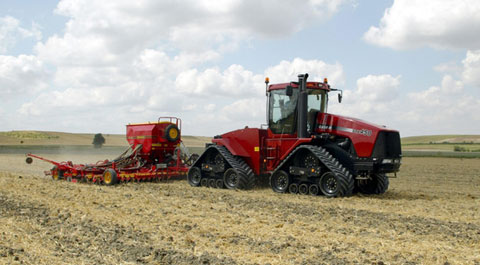
In part one of this series we looked at the basic tractor guidance systems which are normally the choice for say, livestock farmers who want to spread fertiliser on their grassland more accurately or smaller scale arable farmers looking for a low-cost entry level system.
For part two we take a slightly more sophisticated look at the systems which can provide a greater degree of accuracy – usually of between 5cm and 10cm. In part three – coming soon – we will get to terms with the highly accurate RTK scene which can place a tractor within 2cm of where it should be.
The subscription-based OmniStar Hp system or, if you’re John Deere, the StarFire 2 system, is designed to provide a +/-10cm pass to pass accuracy. The system works in very much the same way as Egnos which complements GPS by using data from 34 ground stations to generate a differential correction signal although, as we noted in part one of this series, the accuracy is a generous +/-30cm.
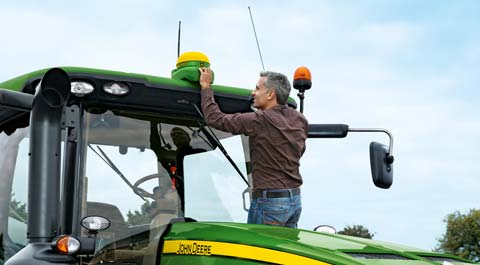
Through use of a dual frequency GPS receiver though, a much higher level of precision can be achieved by being able to draw on data provided by a larger number of satellites positioned around the globe.
In operation, a tractor working in a field receives a signal from a satellite and, at the same time, a geostationary satellite transmits a differential course correction signal to the tractor. The receiver then converts these signals into steering data.
Compare this to RTK (Real Time Kinematic) which, rather than using a correction signal from a second satellite receives its correction data from a land-based reference station and is more accurate as a result.
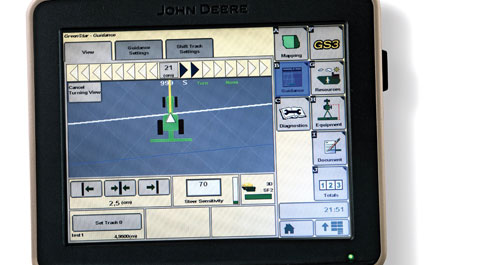
For many operations though, OmniStar HP or StarFire 2 will be more than satisfactory – its degree of accuracy lends itself to cultivation, crop spraying, mowing and top dressing activities.
Worth noting that the stated pass to pass accuracy is only likely to be sustained if the next pass occurs within about 15 minutes of the previous one.
Leave it later, and the error caused by GPS drift could be much larger and possibly beyond the capabilities of a correction signal to bring a machine back to the required place.
Which does raise the question of how such systems are used effectively in the large fields found in eastern Europe or the States where a 15 minute bout rate could be impossible to achieve when performing some operations.
The use for HP/SF2 may also be found wanting when planting row crops, operating a controlled traffic farming system or when strip tilling – the guidance control for these tasks is probably best left to the higher degree of accuracy afforded by RTK.
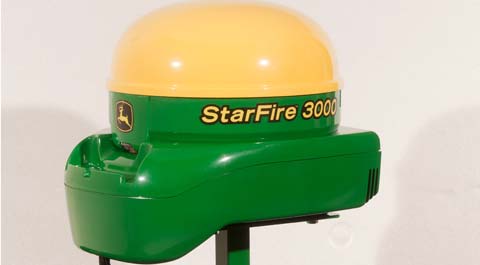
Having said that, there is now reason to believe that the financial savings to be made when performing even seemingly mundane duties, increase in line with the degree of accuracy available.
A tractor with auto-steer and fitted out to receive OmniStar HP or SF2 can expect to perform a more efficient and cost effective job than a tractor with no guidance system on board.
When drilling, for example, a good tractor driver will normally achieve an overlap of about 4% while a tractor with auto-steer and SF2/HP can expect to achieve less than 2% overlap. Those using RTK might achieve just 0.33% overlap.
Such overlaps clearly result in more land being drilled, more seed being used, more fertiliser, more fuel, more labour costs and so on, all of which, over a large acreage can add up to a sizeable extra cost (see tab 6 – financial savings).
Latest development from John Deere is the StarFire 3000 receiver which has been designed to process both GPS and GLONASS signals and, says the company, track weaker satellite signals more efficiently.
The new receiver is compatible with all existing John Deere displays and supports EGNOS, SF1, SF2 and RTK – remote activation and upgrades are available via the company’s Stellar Support website.
Deere has also recently introduced the GreenStar 2630 display which has, for the first time, been awarded the ISOBUS 2011 conformity certificate. The 2630 uses a 26cm full colour display and allows touch screen access to all monitoring and control functions.
The system provides parallel tracking manual guidance and can be upgraded to Auto Trac automatic steering, Auto Trac Universal 200, ITEC Pro automatic headland management, implement guidance and section control.
John Deere StarFire 3000 SF2 cost £3,396 plus £1,829.40 licence fee which covers three years use.
Topcon systems are used extensively by tractor manufacturers to provide guidance systems for their products. One of the latest developments is the System 350 which uses a new X30 console having intuitive multi-view interfaces one of which is autosteering.
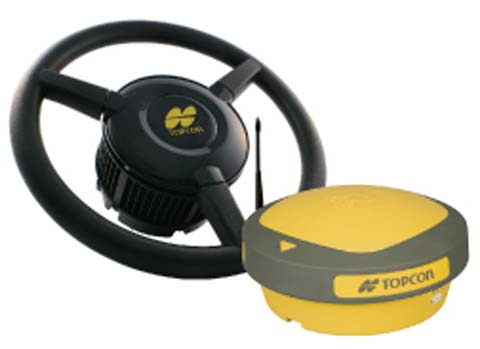
Autosteering eases operator fatigue, reduces machine wear-and-tear, and reduces overlap and input costs. Allows 24/7 operation regardless of environmental conditions.
- Single piece design integrates steering controller with guidance and positioning for reduced cab clutter
- AGI-3 multi-constellation, integrated receiver/steering controller provides high-accuracy autosteering with direct interface for steer ready tractors. Easy to upgrade to RTK or CORS with snap-in module
- Add optional AES-25 to your System 350 for the convenience of electric steering with quick, precise response and up to 2 cm accuracy
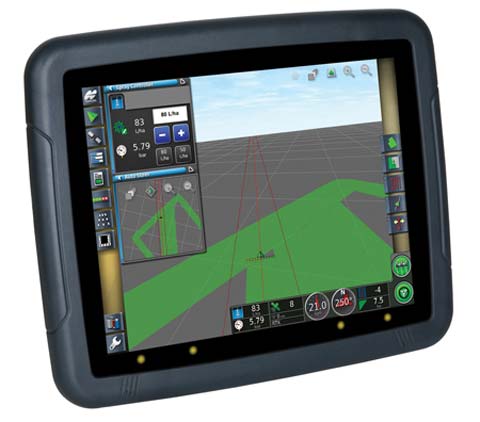
The X30 guidance screen combines views of autosteering settings, dashboard, and multiple product control. Industry standard steering patterns; straight (A-B), identical curve, adaptive curve, and centre pivot allows the operator to work with virtually any field shape. Integrated lightbar provides easy offline reference at a glance.
Topcon 350 price £10,750
The Trimble CFX-750 display is a multi-function guidance display offering key precision agriculture functionality. Compatible with a variety of accuracy levels and satellite constellations, it is considered to be ideal for broad acre and row crop farming applications with almost any crop type, field shape, or soil type.

CFX-750 guidance display features:
- Rugged construction for everyday field use
- Mid-sized 8.0″ colour touchscreen
- Intuitive user-interface
- 27 built-in LED lights
- One built-in dual-frequency GPS receiverGLONASS ready
The CFX-750 display provides seamless operation for many of your precision agriculture applications, such as:
Guidance and mapping
- Coverage, point, line, and area mapping
- Manual guidance for a number of field patterns
- Hands-free guidance by adding EZ –Steer, EZ-Pilot or Autopilot
Price is £2,395
At the heart of Ag Leader’s tractor guidance system is the company’s ParaDyme dual antenna system which can also vehicle pitch, roll, and yaw to maintain greater accuracy.Transferable from vehicle to vehicle, the ParaDyme interfaces with the Integra or Versa in cab display to achieve automated steering.
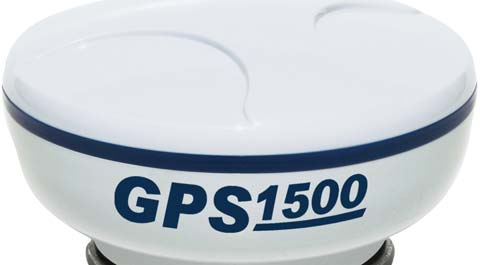
The Integra display is a powerful, full-featured precision farming tool designed for all operations. A full-colour 30cm HD touch screen is easy to read and offers year-round precision farming control including automated steering, mapping, planter and application control, yield monitoring, real-time data logging and more.
The display also features four video camera inputs, providing operators a better view of equipment operation and safety by allowing them to view live video on the display.
AgLeader Integra price £4,995, plus £895 for GPS receiver.
ParaDyme with Omnistar price £14,500
The table below shows the potential savings of GPS systems when using a 6m drill on a 24m tramline system.
Financial savings
| Manual (no guidance) | Medium accuracy (SF2/HP) | High accuracy (RTK) | |
|---|---|---|---|
| Effective drill width m | 5.75 | 5.9 | 5.98 |
| Effective tramlines m | 23 | 23.6 | 23.92 |
| % overlap | 4 | 1.6 | 0.33 |
| Effective area drilled | 13.1 | 12.89 | 12.0 |
| Fuel (50ppl), labour £15/hour machine value/field |
N/A | £74.12 | £91.35 |
| Seed costs @ £54/ha | £707.40 | £696.06 | £680.40 |
| Fertiliser NPK at £252/ha/td> | £3301.2 | £3248.28 | £3175.20 |
| Total cost | £4008.6 | £3944.34 | 3855.6 |
| Variable cost savings for field | £138.38 | £244.35 | |
| Total saving for 500ha | £5491.51 | £9696.43 |
Factors affecting Autosteer systems
- GPS signal accuracy – Just like the SatNav in your car, it can take time for a GPS receiver to “hook up” to its satellites and it can take up to 45 minutes to achieve full accuracy.
- Implement settings – A poorly set implement which does not pull straight due perhaps to unequal loadings or, when mounted, have insufficient room to sway when steering corrections are made can seriously affect the ability of the autosteer to work correctly. Poor settings on front mounted implements can be even more difficult for the system to cope with due to the dynamics and loading on the tractor.
- Tractor set up – Tractors should be correctly ballasted – increasing the weight on the front axle can improve steering control if applicable when performing row crop work. Tyre pressures should also be checked.
- Field and soil conditions – Worth recalling how difficult it can be to keep a tractor on course when soil conditions are difficult for traction and there’s a big implement behind. Then it’s possible to understand just how much work the autosteer system has to do – and there are times when, despite its best efforts, it can be too much to handle.
GPS, GLONASS and GNSS
GNSS is the standard term used to describe a group of navigational satellites which provide signals for global positioning.
GPS (Global Positioning System) is the United States’ constellation of 24 satellites and was developed by the country’s Department of Defence. The system has been the most commonly used navigation system for precision farming however, as other GNSS become more advanced and accurate, there is the opportunity to use other navigation systems so that there is access to more satellites.
GLONASS (Global Navigation Satellite System) is Russia’s GNSS which comprises 23 satellites. Now a popular supplement to GPS, GLONASS increases the number of satellites available for navigation and helps to maintain a strong signal.

